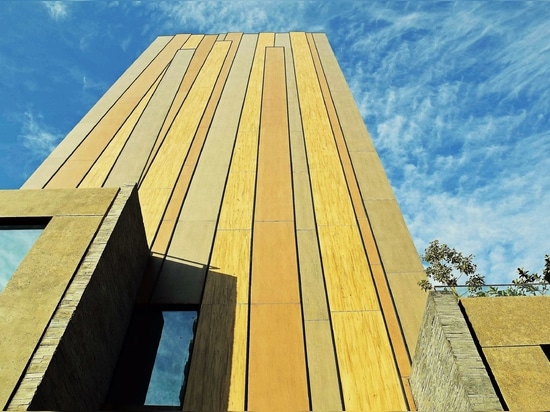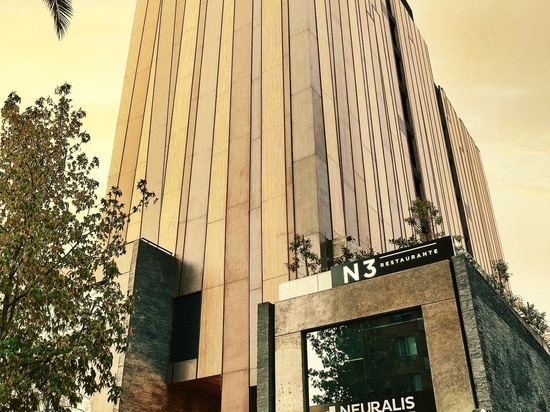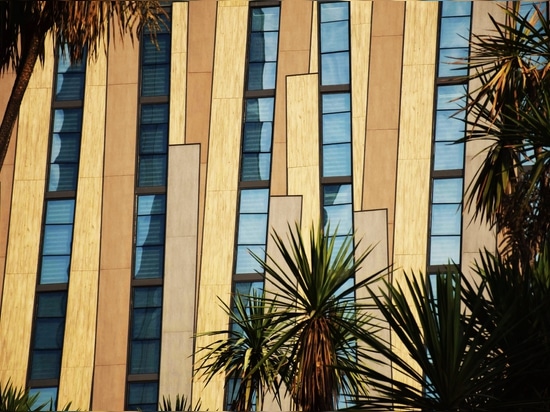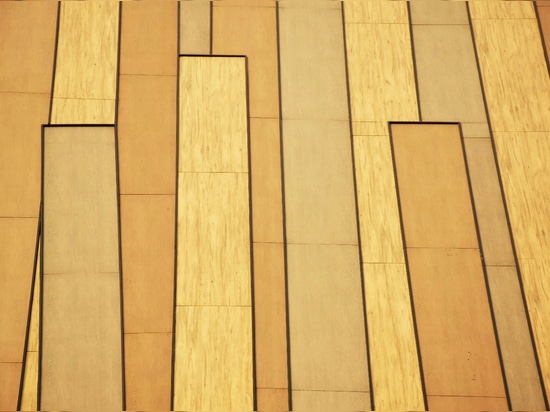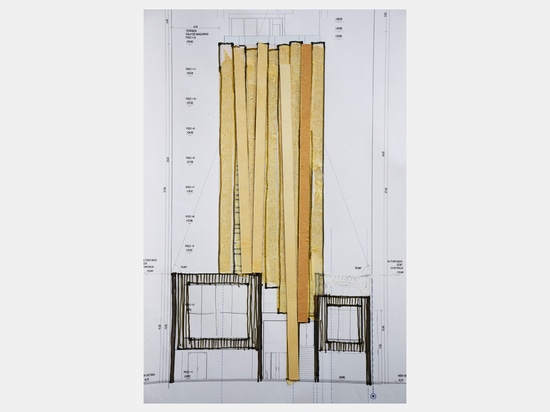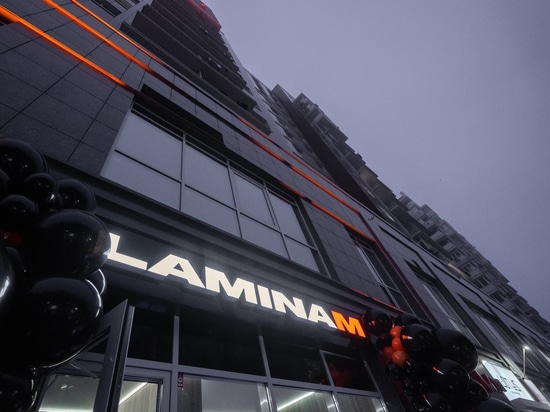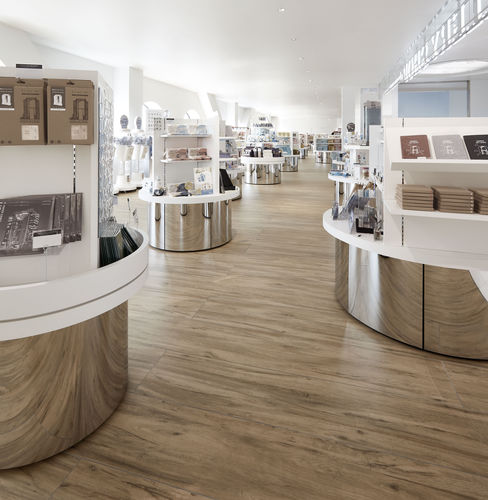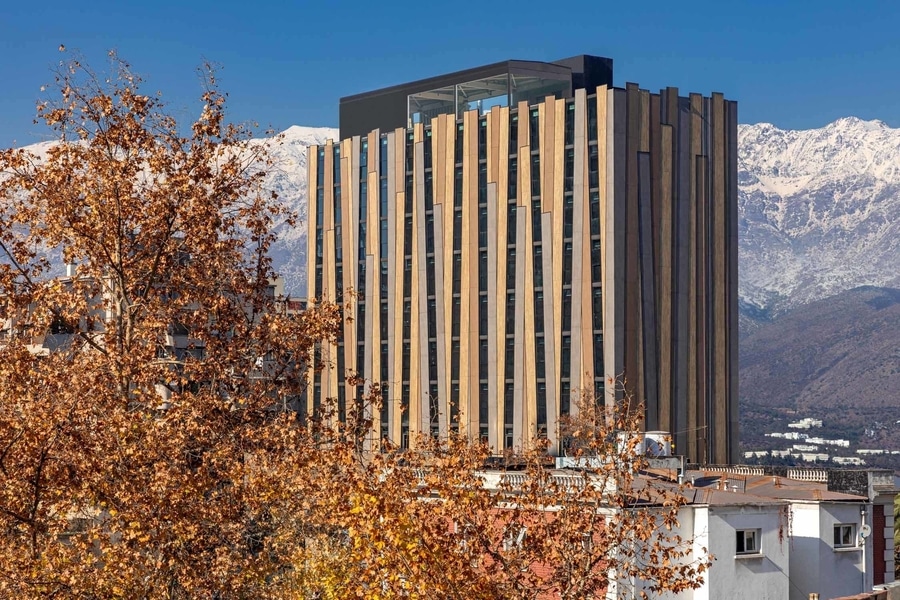
#Industry News
HOTEL NODO IN SANTIAGO, SOUTH AMERICA’S FIRST BIOACTIVE BUILDING HAS LAMINAM CLADDING
RICARDO STEIN’S CONCEPTUAL ALTERNATIVE TO STEFANO BOERI’S “BOSCO VERTICALE” TO FIGHT POLLUTION, IT PRODUCES AS MUCH OXYGEN AS 1.5 HECTARES OF FOREST
Hotel Nodo: “naturally urban”. A hotel with façades covered in Laminam bioactive surfaces was the first building to actively combat South America’s (*) pollution in Chile’s capital. Its architect, Ricardo Stein, designed the hotel to create a building that could not only iconographically reproduce a forest inside a city (just like a landscape), but could function like a forest and purify the air – like an artificial living organism.
Laminam was the first to make this possible. The company supplied the cladding surfaces for the Hotel Nodo in Santiago, Chile making it South America’s (*) first bioactive building. The Italian company’s products treated with bioactive technology were selected by Chilean architect Ricardo Stein, who is specialised in eco-sustainable buildings, for his project. He wanted an architectural element that could aesthetically evoke nature in an artificial area while actively fighting pollution.
Stein explained, “Chile is presented to other countries as a land of landscapes. The Hotel Nodo attempts to iconographically represent landscapes as an element of differentiation, and satisfy the search for unique new experiences for people who temporarily live in a hotel. At the same time, the hotel was built with the intention of artificially reproducing nature and not only for aesthetic reasons. The goal was to create a structure associated with the idea of being a living organism.” To reach his goal, Stein did not choose a design solution that involved natural materials (stone and wood) or the creation of architectural spaces where trees could grow, like Stefano Boeri’s famous “Bosco Verticale” in Milan. Stein opted for a conceptual solution instead.
“Nature is read aesthetically and iconographically,” explained Stein, “with a stone base on which a wooden vertical body grows with a regular-irregular order, as if it were a forest.” However, following the project’s ideal premise, he used concrete for the base and a pillar, beams, and reinforced concrete slab system for the vertical structure. This allowed “maximum flexibility of use, which is essential in multifunctional buildings”. These façades are covered in Laminam’s bioactive ceramic slabs. Stein explained his choice in this way: “We were looking for surfaces that made us think of wood, particularly forest tree trunks to represent the natural element. We needed something that could help fight pollution by acting as an authentic green space. This meant purifying the air like real trees. We realised that the surfaces produced by Laminam could meet image and function purposes.”
Stein found what he was seeking by combining the different textures available in Laminam’s extensive range of finishes with the bioactive treatment. This is an option available on most of the ceramic surfaces manufactured by the Italian company, which has always been a leader in technological innovation. Stein’s decision was influenced by the level of assistance that Laminam offers throughout the project design and construction phases through its Chilean partner, Bercia: “The supplier helped us with the calculations required to install the ventilated façades and technical details for making the anchors,” said Stein. “Its support was invaluable and helped us avoid unforeseen issues during the construction phases, and possibly additional costs.”
The building’s iconic façades are covered with 2,300 sqm of Laminam slabs with a thickness of 3 mm treated with bioactive technology that act like a living plant organism in sunlight and purifies as much air in a year as 1.5 hectares of forest. These surfaces self-clean with rainwater, drastically limiting cleaning and maintenance operations, which saves considerable amounts of money and maintains the building’s features and appearance over time.
On the first through to the third floors, the hotel has public areas: a restaurant, a coffee shop, meeting rooms and a co-working space. The residential rooms are found on the fourth through to the 11th floors. The hotel interiors show Stein’s attention to the environment. “The windows and materials used to insulate the building create an extremely efficient thermal cladding. The HVAC system features heat pumps in cascade connections divided into sectors for each floor. These technical solutions make it possible to reduce energy consumption considerably.” Following the project’s specifications, all materials used for the various building functions are recyclable. “This is what undoubtedly causes us to define the hotel as one of the most sustainable buildings in Chile, from every point of view,” said Stein.
Hotel Nodo: “naturally urban”.
LAMINAM BIOACTIVE SURFACES
Thanks to partnerships with the key players in the nanotechnology field, Laminam can provide clients with bioactive ceramic slabs that have different antibacterial, anti-pollution and self-cleaning surface treatments. These processes take place without a need for electricity or other forms of energy, or the periodic renewal of the compounds required to support the surface reactions. Laminam’s bioactive finishes are particularly suited for eco-sustainable projects. They feature a combination of the aesthetic and performance qualities typical of ceramic claddings with a series of functions that allow them to sanitise the environment and purify the air wherever they are installed. This allows considerable savings on cleaning costs.
LAMINAM – AN INNOVATIVE AND EVER-EXPANDING COMPANY
Established in 2001, Laminam SpA is a specialised manufacturer of large slabs and the first company in the world to have industrialised its production process. It has introduced new applications of use for ceramic surfaces and become a reference point in the architecture, interior decor and furnishing sectors. Creativity, natural raw materials, recyclable products and sustainable technologies are the principles underlying Laminam’s production process. Produced in cutting-edge plants, Laminam’s innovative slabs are made from processing clay and feldspar which has been compacted and transformed into extended surfaces measuring 1000 x 3000 mm (3-5 mm thick), 1200 x 3000 mm (5 mm thick) and 1620 x 3240 mm (5, 12 and 20 mm thick). Hygienic, resistant and extremely elegant, the Laminam slabs provide an architectural skin, to cover external environments (building façades) and internal surfaces (floors and walls). They can be used in the furniture sector for the horizontal surfaces of kitchens, bathrooms and tables and the vertical cladding of doors and furniture.
Over the last few years, Laminam SpA has tripled its production capacity by adding two new sites to the main factory in Fiorano Modenese: the first in Borgotaro (Parma), entirely dedicated to 1200 x 3000 mm and 1620 x 3240 mm slabs, and the second in Russia, in the Vorsino Industrial Park close to Moscow, reserved exclusively for 1000 x 3000 mm slabs. With a consolidated turnover of around 110 million in 2018 and a growth rate of 30 per cent, the company exports its products throughout the world’s five continents. Laminam boasts a rich portfolio of projects worldwide and many important international partnerships, most notably with the Japanese giant Toto Ltd, through which Laminam SpA offers its innovative Hydrotect® photocatalytic treatment, which grants ceramic slabs special air purification and self-cleaning properties.
STEIN-SUAZO’S ARCHITECTURE STUDIO
Stein-Suazo is an architecture firm based in Santiago de Chile, founded in 2009 by architects Ricardo Stein and Felipe Suazo. The firm has developed many nationwide projects, on different scales and plans. Over the years, the firm specialised in the development of office buildings, residential buildings, care homes and hotels, for around 200,000 sqm over 11 years.
The architectural goal of the Stein and Suazo firm is to create unique projects with a strong conceptual base which satisfy the clients’ spatial and building plan requirements. From the original concept to the smallest details they must highlight nature without neglecting design excellence during the process.
E-mail: info@stein-suazo.cl
Sitio web: www.stein-suazo.cl
GENERAL INFORMATION
Project name: Hotel Nodo
Location: Suecia Av. 172, Providencia Santiago / Chile
Year of construction: 2018/19
Building surface area: 9.358 m2
Type of façade: ventilated
Façade ceramic slabs: Laminam various finishes
External surfaces finished with Laminam products: 2.300 m2
Distributor: Bercia (www.bercia.cl; www.bercia.cl/productos/laminam/)
